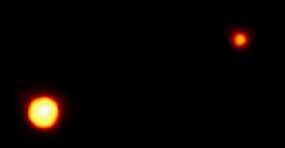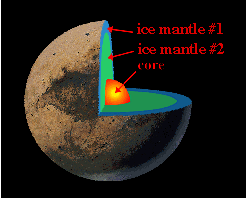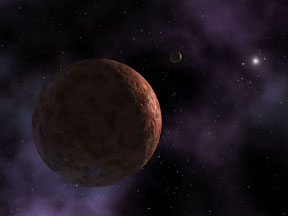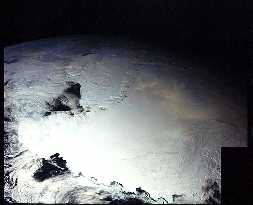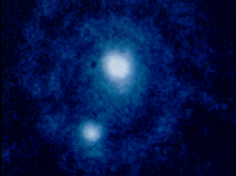Click on image for full size
Image courtesy Dr. R. Albrecht (ESA/ESO Space Telescope European Coordinating Facility) and NASA.
Charon - largest moon of Pluto
Charon is by far the largest of Pluto's known moons. Charon was discovered by the American astronomer James Christy on June 22, 1978, while working at the U.S. Naval Observatory.
Charon is so large compared to Pluto that the pair are often referred to as a "binary planet" (double planet). The radius of Charon is 603.6 km (375 miles), which is about half that of Pluto. The moon also orbits very close to the planet, just over 1/20th the distance between Earth and the Moon. Charon circles Pluto once every 6.4 days at a distance of 19,571 km (12,161 miles). Like Earth's moon, Charon rotates exactly once per orbit, so the same side of the moon always faces the planet. Unlike the Earth-Moon system, this "orbital lock" phenomenon also extends to Pluto; Pluto's day is exactly as long as the orbital period of Charon. This means that Charon is always in the sky when viewed from one hemisphere of Pluto, while an observer standing on the other side of Pluto would never see Charon!
Some astronomers think Charon may have formed in a way similar to the process that created Earth's moon. They think a large object slammed into Pluto early in its history, and that the debris from this collision coalesced to form the moon. Other astronomers disagree, citing the nearly identical densities of Pluto and Charon as evidence which conflicts with this formation theory. According to the theory, Charon should be less dense than Pluto, since it should be made up of material from the outer layers of the planet and not from the denser material at the planet's core. Charon is composed of rock and ice; a little less than 2/3rds rock and slightly more than 1/3rd ice.
Charon is named after a character from Greek mythology. Charon was the ferryman of the dead, who conveyed the recently deceased across a river into the underworld. Hades, the Greek god of the underworld, was called Pluto in Roman mythology. Although the "ch" in the name Charon is pronounced like a "k" in Greek, most astronomers pronounce the moon's name with a "sh" sound at the start. That is because James Christy, the discoverer of Charon, chose to pronounce it that way in honor of his wife Charlene.


